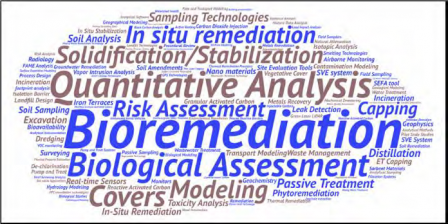EPA's Technical Support Centers
 Word cloud illustrating relative requests made to the EPA Technical Support CentersEPA’s Technical Support Centers (TSCs) offer scientific and engineering expertise to contaminated site decision makers within EPA, including remedial project managers and on-scene coordinators. EPA’s Regional Offices network with the states and tribes within their area to request assistance.
Word cloud illustrating relative requests made to the EPA Technical Support CentersEPA’s Technical Support Centers (TSCs) offer scientific and engineering expertise to contaminated site decision makers within EPA, including remedial project managers and on-scene coordinators. EPA’s Regional Offices network with the states and tribes within their area to request assistance.
Areas of technical support include site characterization, modeling, monitoring, assessment, and remediation technologies. The TSCs advance the use of state-of-the-science information and help ensure coordination and consistency in the application of remedial technologies. The TSCs are actively providing support at many of EPA’s most complex and high-priority cleanup sites, helping to accelerate cleanup operations and advance economic revitalization.
Learn more:
- Obtaining Technical Support for Superfund, Resource Conservation and Recovery Act (RCRA), and Brownfield Site Issues Fact Sheet
- 2019 EPA Technical Support Centers Annual Report (Office of Research and Development)
EPA Technical Support Centers
EPA's Office of Research and Development has five technical support centers:
- Engineering Technical Support Center
Provides short- and long-term assistance to Superfund and RCRA Corrective Action staff. Assistance focuses on treatment technologies and engineering approaches to site management at any phase from problem identification through remedial action.
- Ground Water Technical Support Center
Provides support to EPA staff on issues regarding subsurface contamination, contaminant fluxes to other environmental media (e.g., surface water or air), and ecosystem restoration. The Center creates critical links between research and real-world problems, providing a testing ground for research and allowing scientists to focus on high priority problems.
- Site Characterization and Modeling Technical Support Center
Provides technical assistance on complex hazardous waste site characterization issues through specialized teams of scientists equipped to aid the regions with screening and site characterization. The diversity of expertise available through allows the Center to work with the regional programs at any time during a site characterization event.
-
Superfund Health Risk Technical Support Center
Provides technical support to EPA program and regional offices in the area of human health risk assessment. Examples include the development of Provisional Peer-Reviewed Toxicity Value (PPRTV) assessments, scientific consultations, and support for interpreting Agency publications and other guidance, and risk assessment methods research on chemical pollutants.
-
Ecological Risk Technical Support Center
Provides technical information and addresses scientific questions on topics relevant to ecological risk assessment at hazardous waste sites for Superfund and RCRA Corrective Action staff. Center experts develop state-of-the science responses for ecological risk assessments. Serves as a central communication point distributing responses to interested parties outside the Agency.
Resources for Remediation Professionals
Engineering Issue Paper: Soil Vapor Extraction (SVE) Technology
Citation: Stewart, L., R. Truesdale, J. Redmon, Ed Barth, C. Northeim, AND J. McKernan. Engineering Issue: Soil Vapor Extraction (SVE) Technology. U.S. Environmental Protection Agency, Washington, DC, EPA/600/R-18/053, 2018.
EPA Engineering Issue Papers present the latest information on important waste treatment and site remediation technologies and related issues. They are designed to help remedial project managers, on-scene coordinators, contractors, and other practitioners understand the type of data and site characteristics needed to evaluate a technology for a specific site, as well as ways to design and optimize a technology for a particular application. Engineering Issue: Soil Vapor Extraction (SVE) Technology, assembles, organizes, and summarizes the current knowledge on soil vapor extraction (SVE) technologies that are available for removing volatile organic compounds (VOCs) from unsaturated soils above the water table. As a technical support document, it describes SVE technologies with a focus on remedial scoping needs, but it does not represent EPA policy or guidance.
Read more and access the paper from the EPA Science Inventory: Engineering Issue: Soil Vapor Extraction (SVE) Technology
The Challenge of PFAS Remediation
Citation: Darlington, R., Ed Barth, AND J. McKernan. The Challenges of PFAS Remediation. The Military Engineer. Society of American Military Engineers, Alexandria, VA, 110(712):58-60, (2018).
Soil sorption technologies provide a promising solution to immobilize PFAS in the soils and prevent groundwater and drinking water contamination. The above paper is the result of a collaborative effort between EPA researchers and partners to review the most promising technologies.
Citation: Shultz, M., R. Cramer, C. Plank, H. Levine, AND K. Ehman. Best Practices for Environmental Site Management: A Practical Guide for Applying Environmental Sequence Stratigraphy to Improve Conceptual Site Models. U.S. Environmental Protection Agency, Washington, DC, EPA/600/R-17/293, 2017.
A practical guide on the application of the geologic principles of sequence stratigraphy and facies models to the characterization of stratigraphic heterogeneity at hazardous waste sites. By applying Environmental Sequence Stratigraphy (ESS), practitioners can place high resolution data and other environmental subsurface data in a geologic and hydrogeologic context. ESS provides multiple benefits when applied to complex groundwater remediation sites.
Clu-In (Clean-Up Information) Webinar: Environmental Sequence Stratigraphy and the new EPA Remediation Geology Platform Exit
